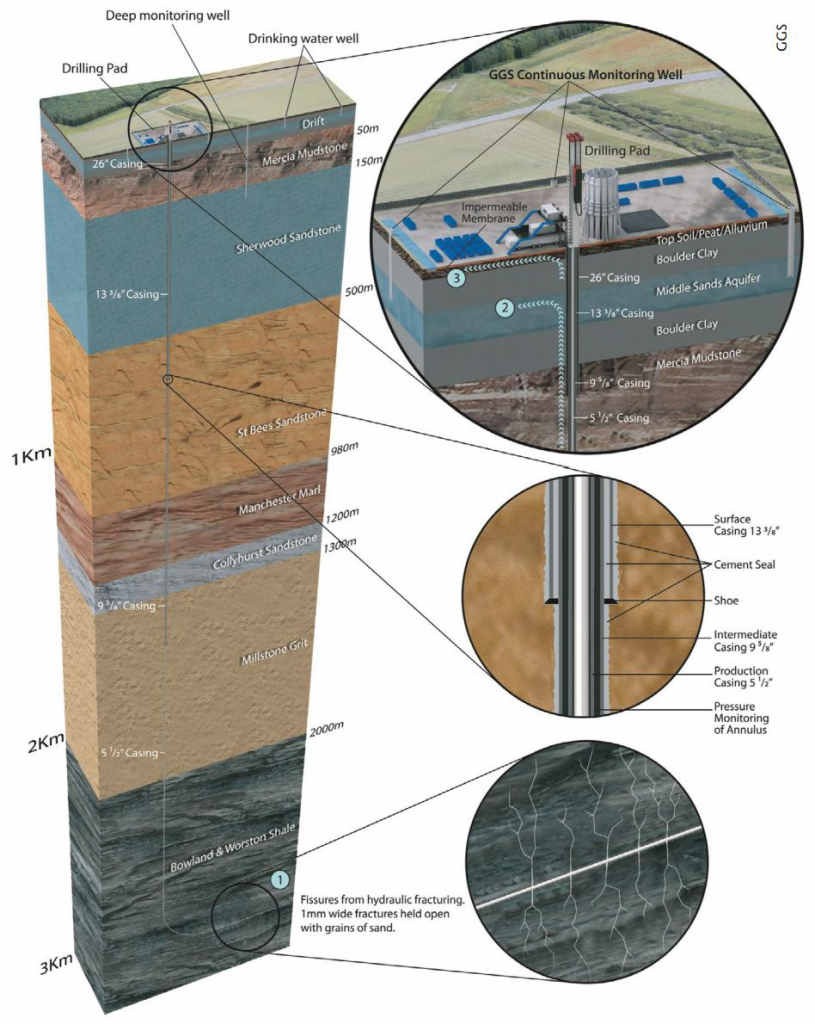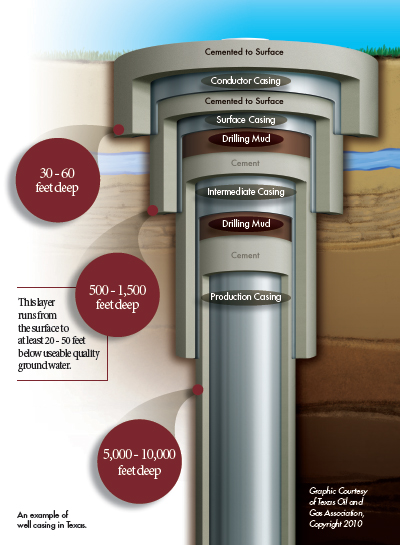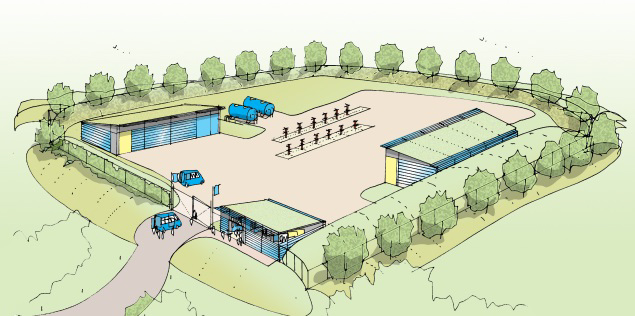
shale gas drilling
Geologists have known for years that substantial deposits of oil and natural gas are trapped in deep shale formations. These shale reservoirs were created tens or hundreds of millions of years ago.
Around the world today, with the use of modern horizontal drilling techniques and hydraulic fracturing, the trapped oil and natural gas in these shale reservoirs is being safely and efficiently produced; gathered and distributed to customers.
During the past 60 years, the oil and gas industry has conducted fracture stimulations in more than two million wells around the world.
Shale reservoirs are usually 5,000 feet or more below the surface. This is well below any underground sources of drinking water, which are typically at depths no more than 300 to 1,000 feet. Additionally, steel pipes called casing, cemented in place, provide a multi-layered barrier to protect fresh water aquifers.
The drilling process of a typical oil and natural gas well is similar for conventional and unconventional wells:
Preparation
Preparing a drilling location is a process that includes the construction of roads to the pad site and the proper grading of the area where the rig and other equipment will be placed. Drilling pads and roads must be built and maintained, including the spreading of stone on an impermeable liner to prevent impacts from spills and must allow precipitation to drain properly.
Drilling
Vertical Drilling

Drill
A hole is drilled straight down using drilling mud that cools the drill bit, carries the rock cuttings back to the surface and stabilises the wall of the well bore. Once the hole extends below the deepest freshwater aquifer, the drill pipe is removed and replaced with steel pipe, called ‘surface casing’.
Next, cement is pumped down the casing and then back up between the casing and the borehole wall, where it sets. This cement bond prevents the migration of any fluids vertically between the casing and the hole. In doing so, it creates an impermeable protective barrier between the well bore and any freshwater sources. Tests are undertaken to confirm the success of this process before drilling further.
Typically, depending on the geology of the area and the depth of the well, additional casing sections will be run and, like surface casing, are then cemented in place to ensure that there can be no movement of fluids or gas between those layers and the groundwater sources.
Horizontal Drilling
What makes drilling for hydrocarbons in a shale formation unique is the necessity to drill horizontally. Vertical drilling continues to a depth called the ‘kick off point’. This is where the well bore begins curving to become horizontal.
One of the advantages of horizontal drilling is that it’s possible to drill several laterals from only one surface-drilling pad, minimising the impact on the surface environment.
When the targeted distance is reached, the drill pipe is removed and additional steel casing is inserted through the full length of the well bore and once again, the casing is cemented in place.
Once the drilling is finished and the final casing has been installed, the drilling rig is removed and preparations are made for the next steps, well completion.
Well Completion
The first step in completing a well is the creation of a connection between the final casing and the rock holding the oil and gas.
A specialised tool, called a perforating gun, is lowered to the rock layer. This perforating gun is then fired, creating holes through the casing and the cement and into the target rock. These perforating holes connect the rock holding the oil and gas and the well bore.
Since these perforations are only a few inches long and are performed more than a mile underground, the entire process is imperceptible on the surface. The perforation gun is then removed in preparation for the next step, hydraulic fracturing.
Hydraulic Fracturing
A mixture of mostly water and sand, plus a few chemicals, the stimulation fluid is pumped under controlled conditions into deep, underground reservoir formations. The purpose of the chemicals is for lubrication, to keep bacteria from forming and to carry the sand.
These chemicals are typically non-hazardous and range in concentrations from 0.1% to 0.5% by volume. They help to improve the performance of the hydraulic fracturing.
In the UK, Cuadrilla Resources were granted approval from the Environment Agency (EA) to use the following non-hazardous amounts of chemicals at their Preese Hall exploration.
- Polyacrylamide (friction reducer)
- Sodium salt (for tracing fracturing fluid)
- Hydrochloric acid (highly diluted with water – for improved efficiency)
- Glutaraldehyde biocide (used to cleanse water and remove bacteria)
So far, only a polyacrylamide friction reducer (0.04%) and a miniscule amount of salt have been used. There was no need to use biocide as the water supplied had already been treated to remove bacteria, and diluted hydrochloric acid was not necessary.
Polyacrylamide is a non-hazardous, non-toxic substance which is also used extensively in other industries to remove suspended solids in drinking and wastewater plants, and pollutants or contaminants from soils. This stimulation fluid is pumped at high pressure from tanks by equipment mounted on lorries or skid mounted on the surface into the well bore and out through the perforations made by perforating gun.
This process creates fractures in the shale, containing the oil and natural gas.
The sand remains in these fractures in the rock, keeping them open when the pump pressure is relieved. This allows previously trapped oil or natural gas to flow to the well bore more easily.
The initial stimulation segment is then isolated with a specially designed plug and the perforating guns are used to perforate the next horizontal section of the well. This stage is then hydraulically fractured in the same manner. This process is repeated along the entire horizontal section of the well, which could extend 1-2 miles.
Production
Once the stimulation is complete, the isolation plugs are drilled out and production begins. Initially fracture fluid, and then natural gas or oil, flows into the horizontal casing and up the well bore.
In the course of initial production of the well, about 25-75% of the fracturing fluid is recovered. This fluid is either recycled for use F4 on other fracturing operations, or safely disposed of according to government and environmental regulations. This whole process of developing a well typically takes from 3-5 months:
- a few weeks to prepare the site
- eight to twelve weeks to drill the well
- one to three months of completion activities and includes between one and seven days of stimulation.
This initial three- to five-month investment could, however, result in a well that will produce oil or natural gas for 20 to 40 years, or more.
Well Abandonment

When all of the oil or natural gas that can be recovered economically from a reservoir has been produced, the land is returned to the way it was before the drilling operations started.
Wells will be filled with cement and pipes cut off 3-6 feet below ground level. All surface equipment will be removed and all pads will be filled in with earth or replanted. The land can then be used again by the landowner for other activities, and there will be virtually no signs that a well was once there.
Today, hydraulic fracturing has become an increasingly important technique for producing oil and natural gas in places where the hydrocarbons were previously inaccessible. Technology will continue to be developed to improve the safe and economic development of oil and natural gas resources.
Source: www.ukoog.org.uk
